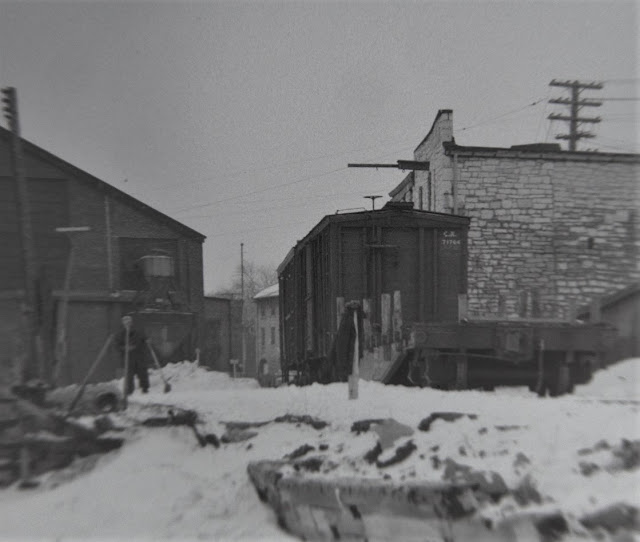Well, you would want them if you were a CN crew charged with stabilizing a 40-foot segment of CN's waterfront trackage across from City Hall. Dating back to the Grand Trunk era, the line was built to enable delivery of Kingston-produced locomotives up to the mainline. The Market Battery was still in place, so the GTR built its track 50 feet out into the lake leaving room for boats to pass through. With the departure of the British garrison in 1875, the battery was demolished, the intervening space landfilled with stone and other spoil from the former battery..
The pile driver sits on the CN track, with CP and other boxcars on the adjacent CP tracks (above). The associated work cars sit on the single track into the Canadian Locomotive Company plant, between limestone buildings lining Ontario Street at right and Swift's Coal dock buildings at left:
So here they are on February 18, 1950. The Toronto-based pile driver, idler flat car and tool/boarding car for and its two man crew under D.J. Garrett, have been pushed down the Hanley spur (still named the Kingston Subdivision at this point, technically!). Nominally this was between the foot of Clarence Street and Swift's Coal Dock. Along with the Bridge & Building crew from Belleville under Foreman C. Rushnell, they are going to work on what looks like a bitterly cold day. A close-up view shows two men on the ice watching the progress, with buoys lining the Brock Street dock in the distance and plowed snow pushed onto the lake ice.
The condition of the wooden retaining wall at water's edge is not optimal. Ties are spilling downwards towards the icy lake. The crew's plan was to drive several 25-foot piles inside the current retaining wall, build a new retaining wall within the piles, remove the old wall and backfill up to the new wall. What they're up against - the relentless wave action, flooding and seasonal effects of the lake upon he Swift's Coal dock at the foot of Johnson Street, this view from May, 1952:
The beauty of having access to these original George Lilley negatives is the ability to zoom in to details, making two photos into five. Of course, only one highly-cropped, newsprint-dotted photo made it into the Whig. The top photo is one of two I ordered small square prints of from the Archives a couple of decades ago!
(Photos in this post from the Queen's University Archives)


.JPG)



No comments:
Post a Comment
I'm happy to hear from you. Got a comment about the Hanley Spur? Please sign your first name so I can respond better.